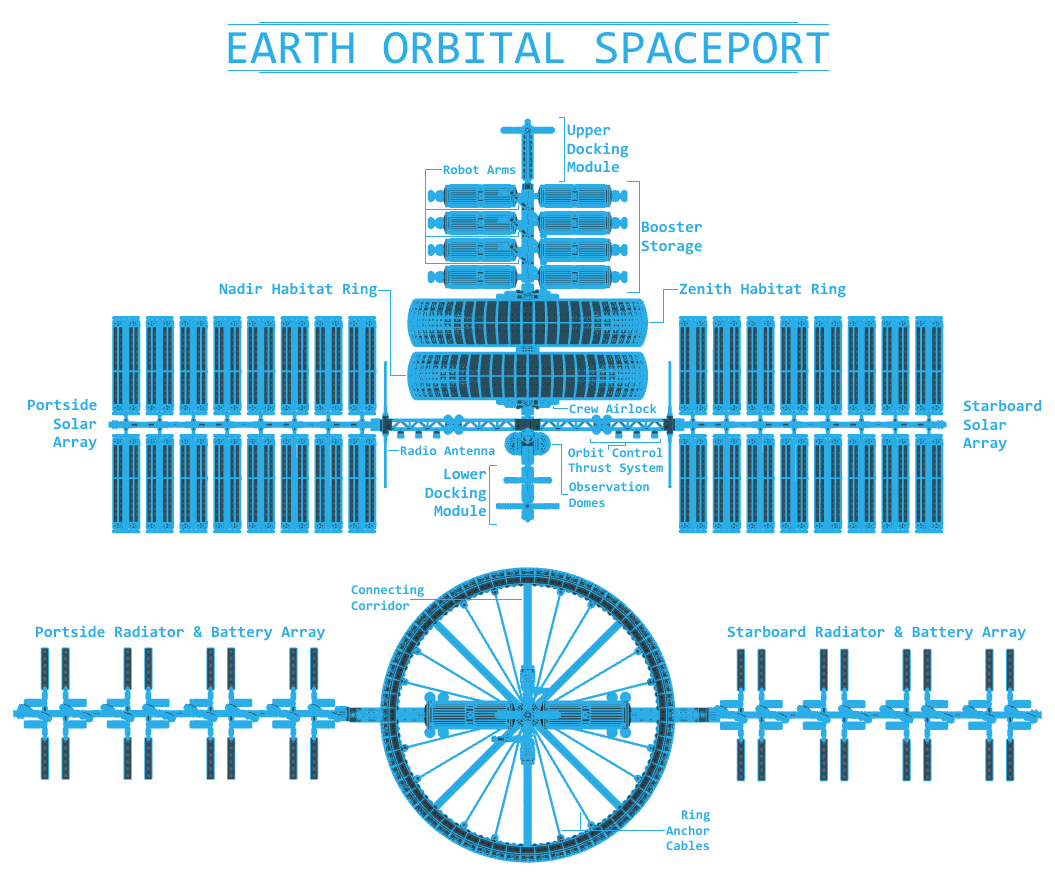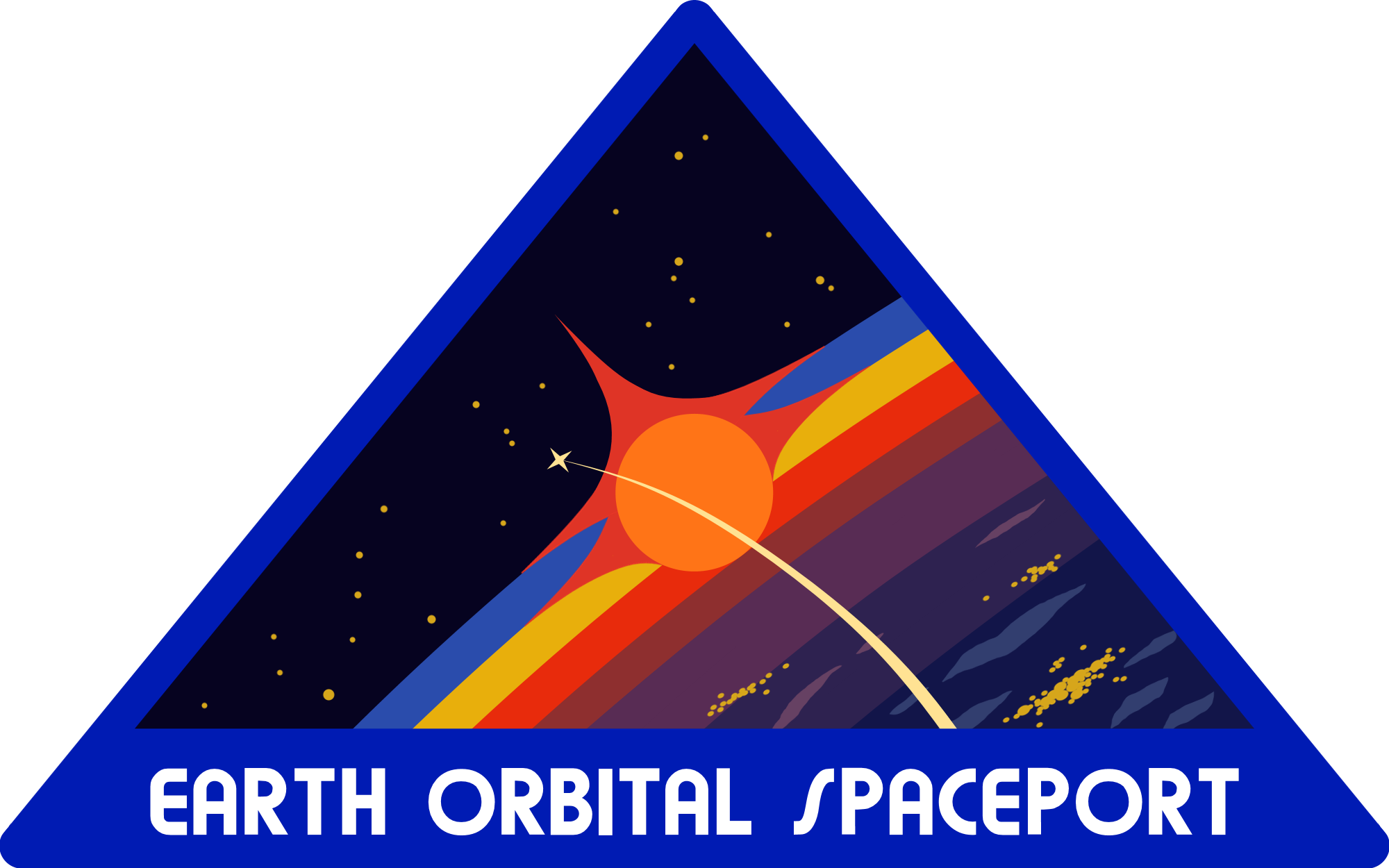Earth Orbital Spaceport
Earth Orbital Spaceport (EOS) was a modular space station in low Earth orbit which was built to replace the aging International Space Station as humanity's primary gateway to interplanetary space. Its operational life as the orbital base of the United Nations Aerospace Commission lasted from 2037 to 2112 CE, and over the course of those seventy-five years the station greatly helped human civilization to flourish across the wider Sol system. As of the present day the station is under conservation in a parking orbit around the Earth-Moon trailing Lagrange point. EOS shares its name with the ancient Greek goddess of the dawn, which is elegantly symbolic of its place in history: overseeing the dawn of permanent human presence in space.
Structure
EOS was one of the crowning achievements of 21st-century space construction. Thanks to advances in surface-to-orbit technology and Luna-based manufacturing it was able to be far larger than any station before it, and it had the advantage of being specifically designed for the role rather than hastily adapted from a scientific outpost like the ISS had been. Its total width across the main truss from the starboard end to port end is around 350 meters, and its height from zenith to nadir is about 170 meters. In total, the pressurized volume of the station is approximately 75000 cubic meters —more than eighty times that of its predecessor.Habitat Rings
The most notable feature of EOS is its twin counter-rotating habitat rings. The rings, which combined make up nearly three quarters of the station's pressurized volume, have diameters of over a hundred meters and are spun at roughly 4.2 rotations per minute in order to provide one Earth-gravity of centrifugal force for its inhabitants. Power and fluids are provided to the habitat rings via a slip ring system with ferrofluid seals, allowing coolant, water, and air to be easily cycled between the rotating and static portions of the station.Solar Arrays
EOS is also striking for its pair of enormous solar arrays, which provide a peak power output of over half a megawatt in full sun. The battery arrays along the main truss allowed the station to run all of its systems and those of every docked vessel even during the 45-minute dark periods.Fuel Depot
The depot module toward the station's zenith historically held several standard reusable booster tanks at all times, intended to resupply outward-bound vessels either by direct affixion or by transferring the chemical fuel to a vessel's own tanks. The depot has berths for up to eight boosters, as well as six remote-operated manipulator arms to assist in fueling operations.Other Features
EOS sports two docking towers; one at either end of the station. The docking tower at zenith was designed for larger orbital and interplanetary spacecraft, like haulers and ferries, while the nadir docking tower was designed to accommodate up to eight surface-to-orbit shuttles at a time. EOS also boasted twin zero-G observation domes, four crew airlocks, four atmosphere-capable emergency escape shuttles, six powerful stationkeeping engines, and a potent long-range communications array to manage the spacelanes in Earth's gravitational sphere.History
EOS was first conceived by UNAC in the mid-2020s as a solution to the increasingly apparent bottleneck in LEO. The International Space Station had served as an excellent orbital platform in the early days of interplanetary travel but it was already a quarter century old, quite small, and ill-equipped to function as much more than an orbiting laboratory. With a long-term operation now firmly established on the surface of Luna and several ambitious orbital construction projects on the way, the UN space agency would soon be in dire need of a proper spaceport. Their plans called for a large space station with a semi-permanent crew, which could serve as a refueling depot and traffic control center in the rapidly-crowding low Earth orbit. Once the project was fully planned and approved, construction on the first modules of the Earth Orbital Spaceport began in earnest. The first of these –the core module, to which the main truss would later be attached– was lofted to orbit in 2028, followed by sections of the main truss and primary habitat module. The impressive rotating habitat rings were manufactured on Luna due to their size, and gently shipped to LEO with autonomous boosters. Station assembly was completed in February of 2037, just in time to see the first crew of the International Mars Research Station off to their own orbital outpost two hundred million kilometers away. EOS remained a fixture of low Earth orbit for well over 75 years, until its eventual replacement by the even larger (and more permanent) Gaia Station in 2105. It was officially decommissioned in 2112, and like its predecessors was towed to rest in a stable Earth-Moon L4 orbit where it remains as a historical monument. Its conservation is currently managed by the Human Spaceflight Legacy Group, a non-profit organization dedicated to preserving the story of humankind's ascension to the stars. (Tours must be reserved five days in advance.)Archive Data
ORBITAL CHARACTERISTICS (HISTORIC)





Comments